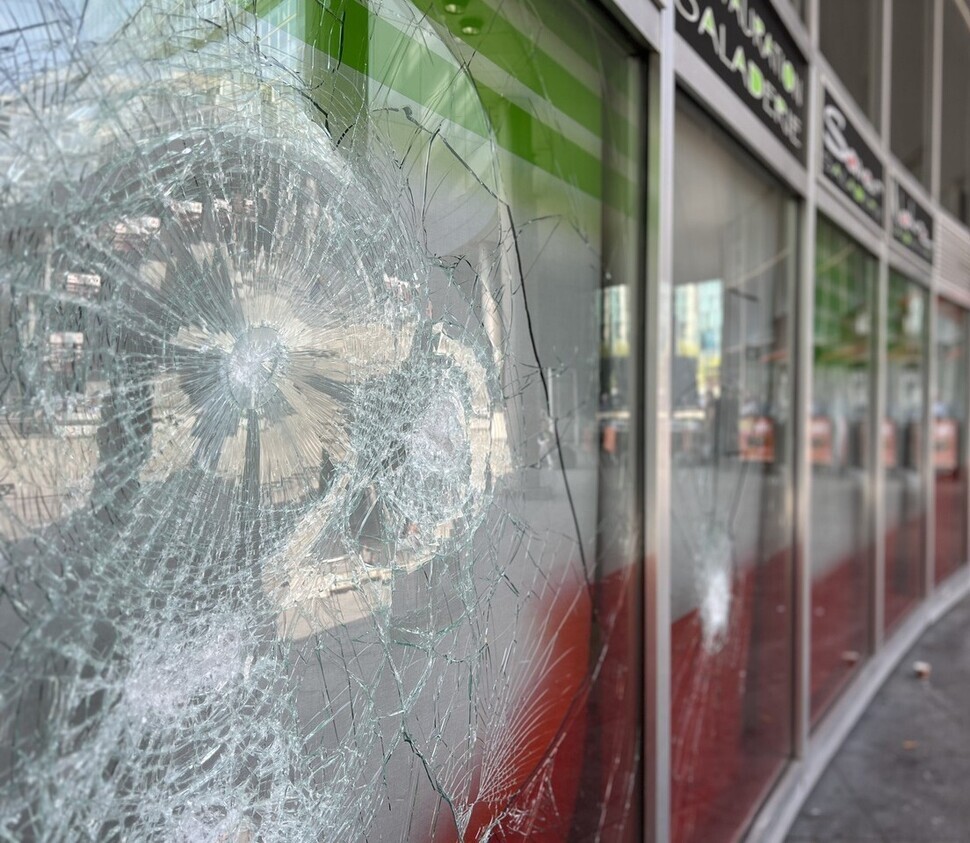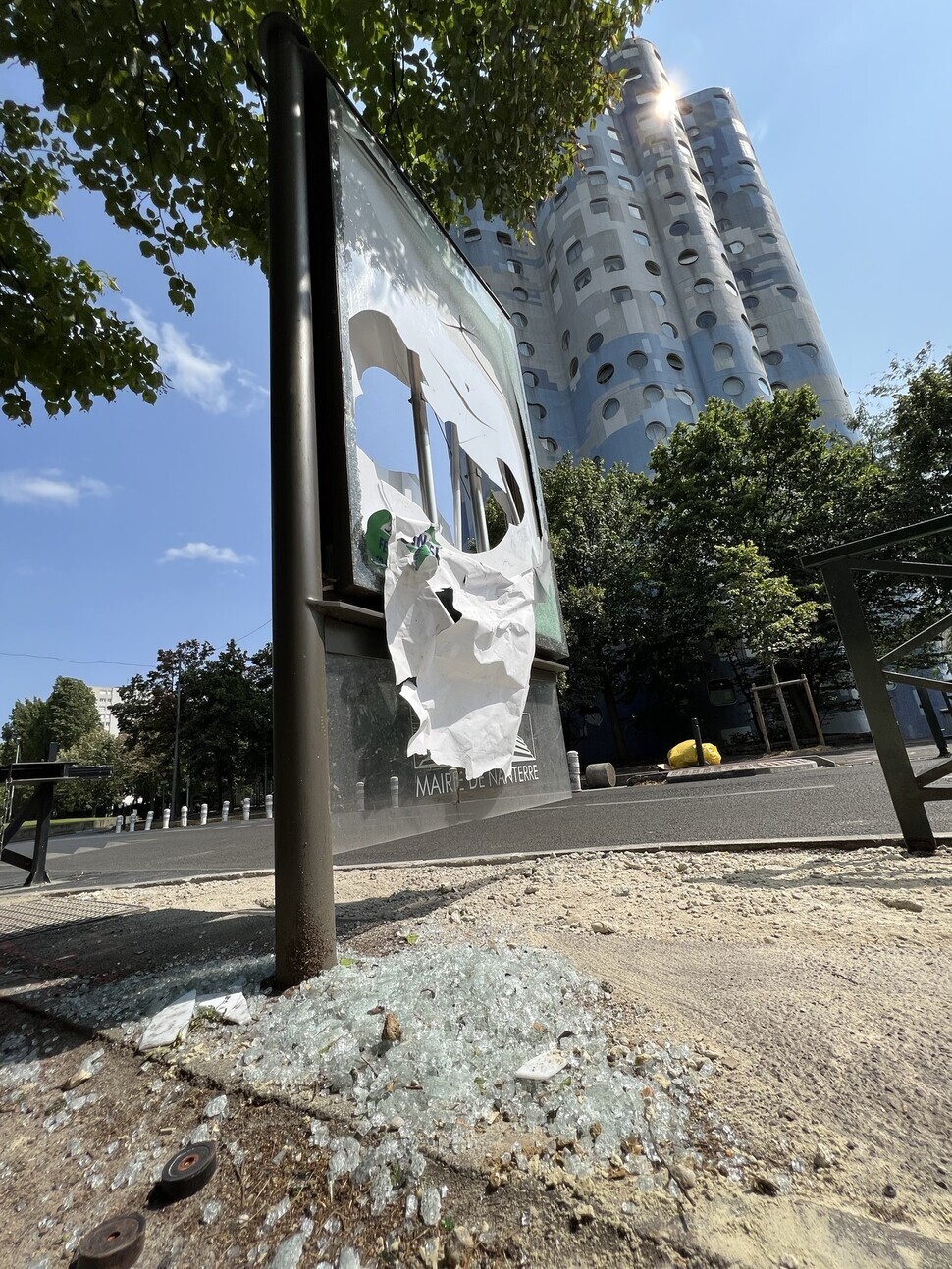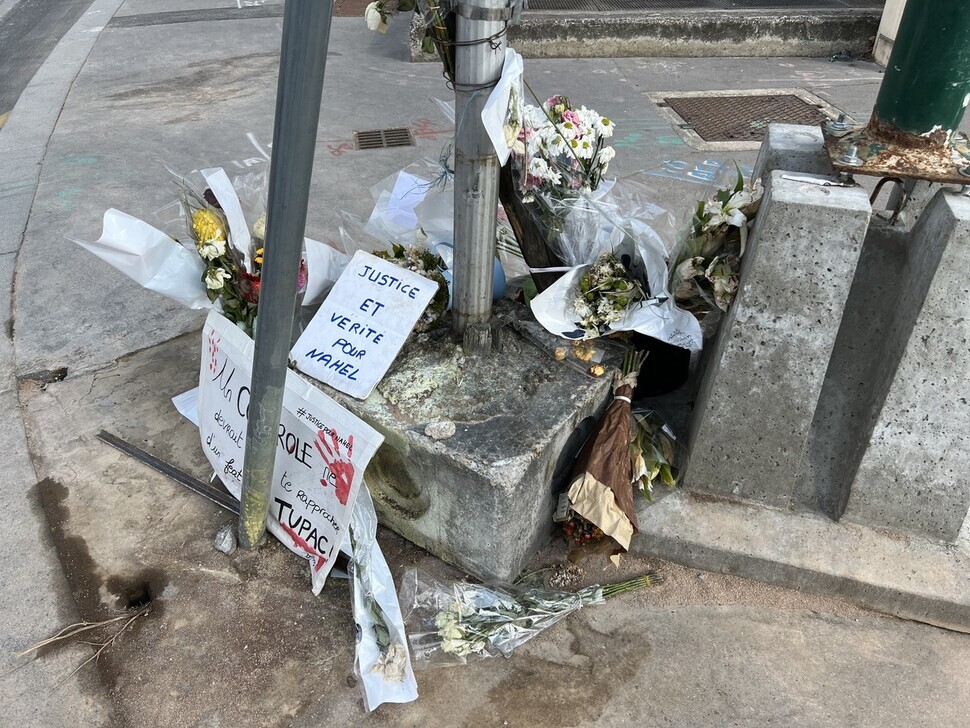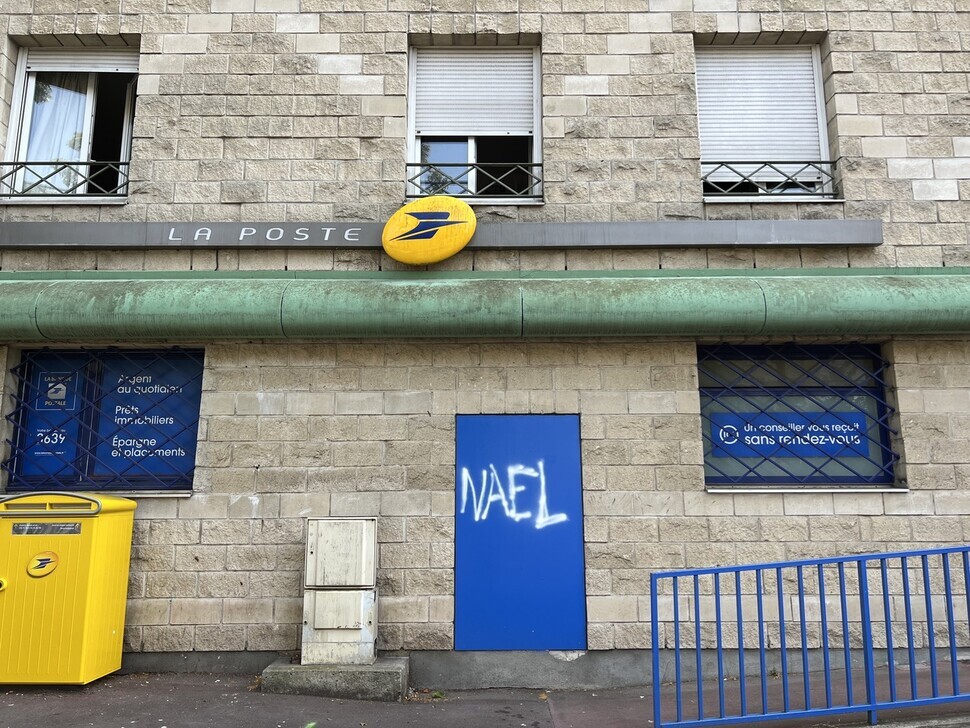hankyoreh
Links to other country sites 다른 나라 사이트 링크
[Reportage] “Immigrants will never be considered French”: A Korean reporter heads to Nanterre

“Immigrants will never be considered French. That’s the reality.”
Umit Donmez, 41, an independent journalist that I met on Monday afternoon in Nanterre, in the northwestern suburbs of Paris, was one of the first people to arrive at the scene when protests erupted there a week ago.
On the morning of June 27, Nahel Merzouk, a 17-year-old of Algerian descent, was shot and killed in the middle of Nanterre by a police officer. As a journalist, Donmez felt compelled to cover as a journalist.
But that wasn’t all. Donmez was also forced to revisit a lifelong injustice: He was born in Türkiye and is a second-generation immigrant who arrived in France with his parents at the age of 2. He now works as a freelance journalist, sending stories to news agencies in Türkiye.
“The police pointed guns at me as soon as they laid eyes on me. They only put them down when I shouted that I was a journalist.”
The guns aimed at Donmez, mistaking him as a protestor, were rubber bullet devices, weapons that can inflict lethal injuries.

Protests erupted in Nanterre mere hours after news of Nahel’s death became public. The day after, the demonstrations spread across the country. Over the past six days, 5,600 cars and 1,000 buildings have been torched or vandalized. Over 250 police stations and 99 town halls have been attacked by protestors.
French authorities have chosen a heavy-handed response, deploying 45,000 police officers and mobilizing armored vehicles and SWAT teams.
So far, more than 3,354 people have been arrested by police. Those arrested have an average age of 17, and 60 percent of them have no prior criminal record.
On the first day of the protests, when emotions ran high in the heated environment, the protesters treated Donmez with hostility.
They let down their guard when they realized that he was not a journalist from a mainstream French media outlet.
“They didn’t cooperate with me until I confirmed that I was not from BFM,” he said, referring to the French broadcaster. “They don't trust these sorts of media because they think they are biased [against immigrants].”

Donmez called the recent protests in France “an outburst of anger that has been building up for a long time.”
“It’s about discrimination, double standards, and injustice,” he remarked.
As of Monday, almost a week after the incident, the protests seemed to have subsided somewhat. But the air in Nanterre, the epicenter of the outrage, is still tense.
Traces of the fiery protests still peppered the streets. Of 19 cars parked along one side of half a kilometer stretch of Av. Pablo Picasso, 10 had been torched, leaving only skeletal remains. The glass panes of bus stops had all been shattered. Traffic barriers had been wrenched from the pavement, and metal signposts were bent out of shape if not uprooted entirely.
Everywhere there was glass, there were signs of the heat of the protests: smashed ATM machine screens, shattered windows of supermarkets and restaurants. Spray-painted messages reading “F*** the police” and “Justice for Nahel” filled the walls of the neighborhood.
A man, warily watching as I, an outsider, took pictures of the scene, pointed his wooden bat at me and told me to leave. A local onlooker explained, “It’s dangerous here,” and suggested that I take off my press badge, stop taking pictures, and leave the area quickly.

Nearly no white people could be seen on the streets. As of 2021, France was home to around 7 million immigrants, or 10.3% of the overall population. A significant number of these immigrants live in banlieues, or suburbs, like Nanterre some 10 kilometers from the Parisian urban center.
Only upon reaching an area filled with newer, taller buildings where the metro train runs did I see white people, including Damien, 26.
“It’s true that the police made a mistake, but there’s no need to destroy supermarkets or banks,” he shared. “I doubt whether they know why they’re in the streets, or what the protests are even about.”

There is a difference in point of view of the death of Nahel and the clashes between protestors and police among French locals that proves difficult to bridge.
Sami, 44, who works at a restaurant in Paris, said that racism was the cause of the unrest. “It’s something people of color like me experience daily,” she added. Sami was born in France to Algerian immigrants.
“There are two classes of citizens in France: whites and immigrants,” she shared. “We’re stopped by police on the street three to five times more than white people.”
Quoting a 2017 study by a civil rights research organization, the Wall Street Journal recently reported that in the last five years, men perceived to be Black or Arab were stopped for identification by police at a rate three times higher than their white counterparts. Men of color were nine times as likely to have been stopped in excess of five times by police.
When I asked if she thought that some of the protestors’ actions were excessively violent, Sami responded, “The current social structure itself is violent,” repeating her point back to me three times for emphasis.
“No matter how smart I am or how much I study, good jobs go to white people. I can’t get a job because of my obviously Arab name, or my address in the outskirts of Paris [where immigrants tend to live].”
By Noh Ji-won, Berlin correspondent

Please direct questions or comments to [english@hani.co.kr]

Editorial・opinion
![[Column] How opposing war became a far-right policy [Column] How opposing war became a far-right policy](https://flexible.img.hani.co.kr/flexible/normal/500/300/imgdb/original/2024/0702/5017199091002075.jpg) [Column] How opposing war became a far-right policy
[Column] How opposing war became a far-right policy![[Editorial] Korea needs to adjust diplomatic course in preparation for a Trump comeback [Editorial] Korea needs to adjust diplomatic course in preparation for a Trump comeback](https://flexible.img.hani.co.kr/flexible/normal/500/300/imgdb/original/2024/0702/9717199086060096.jpg) [Editorial] Korea needs to adjust diplomatic course in preparation for a Trump comeback
[Editorial] Korea needs to adjust diplomatic course in preparation for a Trump comeback- [Editorial] Silence won’t save Yoon
- [Column] The miscalculations that started the Korean War mustn’t be repeated
- [Correspondent’s column] China-Europe relations tested once more by EV war
- [Correspondent’s column] Who really created the new ‘axis of evil’?
- [Editorial] Exploiting foreign domestic workers won’t solve Korea’s birth rate problem
- [Column] Kim and Putin’s new world order
- [Editorial] Workplace hazards can be prevented — why weren’t they this time?
- [Editorial] Seoul failed to use diplomacy with Moscow — now it’s resorting to threats
Most viewed articles
- 110 days of torture: Korean mental patient’s restraints only removed after death
- 2Nine dead in Seoul after car plows into pedestrians
- 3[Editorial] Korea needs to adjust diplomatic course in preparation for a Trump comeback
- 4[Column] How opposing war became a far-right policy
- 5Samsung Electronics workers to go on first strike in company’s 55-year history
- 6[Editorial] Silence won’t save Yoon
- 7Japan is building a military meant for more than self-defense — and has the US to thank for it
- 8Korea to create dedicated population strategy ministry to combat low birth rate, aging society
- 9[Column] The miscalculations that started the Korean War mustn’t be repeated
- 10Son Heung-min’s father, brother accused of child abuse at football academy